Set off for spring-2019, 3. Drive by yourself and go to spring. (3) Xi'an and Hanzhong.
Spring is a deeper feeling for northerners. The vast land has turned from bleak to desolate, the north wind howling to the night when there is little frost, and the spring breeze sends warmth into Tusu. Entering the vernal equinox, the strong sense of spring comes to your face. The wind goes from biting to genial, the trees go from dry to tender shoots all over the branches, and the flowers are about to sprout. Suddenly, it was like the spring breeze came overnight, and thousands of trees and pear blossoms bloomed. Traveling during this period of time must be "the most beneficial thing in the spring, with thousands of miles of warblers singing green and reflecting red." On March 20, my lover and I followed the footsteps of spring and started a spring trip.
stroke
Day1(2019, March, 20): 6.26, depart from Daxing, Beijing, G4 Expressway, 12.06, arrive at Yin Ruins Site (odometer shows 495km). 12, 40 -15.20,"Shengdeli" lunch, visit the Yin Ruins ruins. 15.48, Ma Manor. 17.20, stay at Lavande Hotel (543km). 19.38,"76-person old-fashioned handmade stewed noodles" dinner.
Day2(2019, March, 21): 6.47, departing from Lavande Hotel in Anyang, Nanlin Expressway, 8.17-12.10, Hongqi Canal Youth Cave Scenic Area (631km). 16.59, Dayuncheng Manxin Hotel (1050km). 18.33 Dinner at "Longxingmei Noodle Restaurant".
Day3(2019, March, 22): 7.46, check-out departure, 8.00-8.50, Colorful Salt Lake (1057km). 9.22-11.00, Xiezhou Guandi Temple (1082km). 11.56-12.43, lunch, Yongji Puji Temple (1150km). 13.10-14.26, Guanque Tower (1157km). 17.25, stayed at Xi'an Aegean Hot Spring Hotel (1327km). 18.45,"Lintong Impression" dinner.
Day4(2019, March, 23): 8.10-12.08, Huaqing Palace. 12.50-15.10, Big Wild Goose Pagoda (1396km). 15.41, stay at the Ibis hotel (1405km). 18.00-21.08,"Liuxiang Noodles" dinner, and visit Hui Street.
Day5(2019, March, 24): 8.50-11.55, Xi'an City Wall. 12.10,(Lao Tongguan) Lunch. 12.43, set off for Hanzhong. 16.30, stay at Hanzhong Binjiang Garden Hotel (1670km). 18.00-21.00, stroll along the Han River, dinner.
Day6(2019, March, 25): 6.22-7.50, walking along the Han River. 8.42, check out. 9.19-13.50, Xiema Township, Hongfu Road, Hanshanding, Yangchun Town, Nanzheng South Lake, enjoy rapeseed flowers (1750km). 14.00, heading towards Guangyuan. 15.50, stay at Hampton Inn Guangyuan (1915km). 18.05-20.30 Dinner, hanging out.
Day7(2019, 3, 26): 8.28, departure. 9.16-12.08, Zhaohua Ancient City,"Zhaohua Taste" lunch (1946km). 17.08, stayed at Leshan Golden Begonia Hotel (2389km). 17.30-21.10, intersection of three rivers, Leshan Giant Buddha,"Leshan Taste" dinner.
Day8(2019, March, 27): 6.50-8.00, walking along the river. 8.42, check-out departure (2406km). 9.41-14.25, Qianwei Jiayang Small Train (2471km). 16.40, stayed at Ya 'an Yucheng Impression Hotel (2642km). 17.05, stroll around and have dinner at "Fat Shi Fish House".
Day9(2019, March, 28): 8.40, departure. 12.42-15.48, Qionghai National Wetland Park (2943km). 16.04-17.30, Lushan. 18.08, stayed at Xichang Beautiful Shanshui Hotel (2957km). 19.20,"Niu Muke" dinner.
Day10(2019, March, 29): 8.00, departing towards Lugu Lake (2960km). 13.45, Gate of Lugu Lake in Yanyuan County (3201km). 14.30-15.18, Caohai, Zouzhuang Bridge (3205km). 16.03, Daluoshui Village Parking Lot (3221km), 16.20, check into Manidii Hotel. 16.50-20.00, walk by the lake, dinner.
Day11(2019, March, 30): 6.50, taking photos by the lake. 9.20-15.40, Tour around the lake (3299km). 18.30-20.00, hanging out, dinner.
Day12(2019, 3, 31): Visit Daluoshui Village and Lugu Lake.
Day13(2019, April, 1): 9.30, towards Lijiang, 14.00, check into Shuhe Mozhu Washe Inn (3496km). 14.30-17.30,"Small Pot Rice" lunch, visit Shuhe Ancient City. 18.20-22.00, visit the ancient city of Lijiang and have dinner with the "Lao Wang Next Door".
Day14(2019, 4, 2): 6.20-8.40, stroll around the ancient city of Shuhe. 9.26, towards Panzhihua, 15.48, stay at Panzhihua Zhuxia Hotel (3763km). 18.20-22.00, stroll around,"a handful of bones" dinner.
Day15(2019, April, 3): 8.50, towards the Dongchuan red soil. 15.02-18.10, visit the Dongchuan red soil and take photos (4165km-4205km). 19.26, stayed at Century Regent Hotel Dongchuan (4249km).
Day16(2019, April, 4): 7.50, towards Bijie, 12.30-17.40, Baili Rhododendron Scenic Area (4689km). 21,55, stayed at Bijie Southern Excellence Hotel (4770km).
Day17(2019, April, 5): 9.00, departing for Longsheng, Guangxi, 15.49, ticket office of Longji Terrace Scenic Area (5351km), 17.38, Ping 'anzhai Parking Lot (5392km), 18.35, check in "Seven Stars Accompanying the Moon Resort Hotel".
Day18(2019, April, 6): 6.30-8.00, taking photos of Longji Terrace. 9.40, depart for Dongjiang Lake in Zixing City, Chenzhou, Hunan Province, 15.10, and stay at Zixing Dongjiang Lake Kistler Hotel (5856km). 16.00-19.00, walk,"lipped fish" dinner.
Day19(2019, April, 7): 7.20-11.30, tour Dongjiang Lake, 12.10, go to Yingtan, Jiangxi, 18.45, stay at Fontainebleau Hotel, Yingtan (6451km).
Day20(2019, April, 8): 7.00, heading for Jiande City, Zhejiang Province, 11.00, Jiande Qili Yangfan Scenic Area Parking Lot (6785km). 11.40-13.35, visit the Fuchun River and have lunch at Kaiyuan Fangcao Village Hotel. 14.30, stay at Tonglu Daman Hotel (6841km). 18.00-21.40, Tonglu County,:
Day21(2019, April, 9): 6.30-8.00, play along the Fuchun River, 9.50-11.30, Daqishan National Forest Park. 18.20-21.10, Tonglu County, stroll around and have dinner.
Day22(2019, April, 10): 9.50-15.00, lunch for "mother-in-law" along the Fuchun River, Tianmu Creek, Fenghuang Mountain, Tongjun Cable Bridge, and Binjiang Park. 19.00-20.40, Tonglu County, stroll around and have dinner.
Day23(2019, April, 11): 9.00, heading for Nanjing (6885km), 12.02, lunch at "Dushun Xing Zhenjiang Pot Cover Noodles" in Yixing. 14.08, stayed at Nanjing Orange Crystal Hotel Yixianqiao Branch (7247km). (I have to do a test in Nanjing and see a doctor in two days.)
Day24(2019, April, 12): 8.45, going to Xinghua, 11.06-13.50, Xinghua Qianduo Scenic Area (7466km), 16.50, staying at Suzhou Geya Hotel (7696km), 17.30-21.20, Jinji Lake, dinner.
Day25(2019, April, 13): 9.40-13.45, Jinji Lake. 14.20, stay at the Loft All Suites Hotel. 17.40-21.30, Pingjiang Road,"Dingsheng Xian" dinner.
Day26(2019, April, 14): 8.50, heading to Tianmu Lake, 10.59-13.30, Tianmu Lake Shanshui Garden, Lunch (7876km). 14.45, stay at Nanshan Bamboo Sea Inn (7921km). 16.20-19.30, Tianmu Lake Yushui Hot Spring.
Day27(2019, April, 15): September 17, to Nanjing, 12.30, Nanjing Zhongshan Hotel (8056km). (Nanjing General Hospital takes a test sheet and sees a doctor). 15.15, heading to Xuzhou, 18.50, stay at Xuzhou Pengcheng Hotel (8394km).
Day28(2019, April, 16): 5.40, departing for Beijing, 12.46, arriving at home in Daxing, Beijing (9076km).
route
Beijing--Henan--Anyang--Hongqi Canal--Shanxi--Yuncheng--Yongji--Shaanxi--Xi'an--Hanzhong--Sichuan--Guangyuan--Leshan--Qianwei--Ya' an--Xichang--Lugu Lake--Yunnan--Lijiang--Sichuan---Panzhihua--Guizhou--Bijie--Guangxi--Longsheng--Hunan-Zixing--Jiangxi-Yingtan--Zhejiang-Tonglu--Jiangsu-Nanjing--Xinghua---Suzhou-- Liyang--Nanjing--Xuzhou-Beijing.
Xi'an
Crossing the Yellow River Bridge from Fengling to Shaanxi, and staying at the Aegean Hot Spring Hotel near Huaqing Palace that night.

The hotel has a quiet and elegant environment, but the conditions in the Huaqingyuan area where we live are average.

The place for dinner is called "Lintong Impression", which is about two or three kilometers away from the hotel. The business is booming and the environment is average. The most unacceptable thing is that many people smoke. The food is really delicious. Grandma's oil cakes are the best oil cakes I have ever tasted.

The next morning, I went to wash the car, and my wife went to Huaqing Palace to play (I had been there before).
Come to the Big Wild Goose Pagoda at noon.
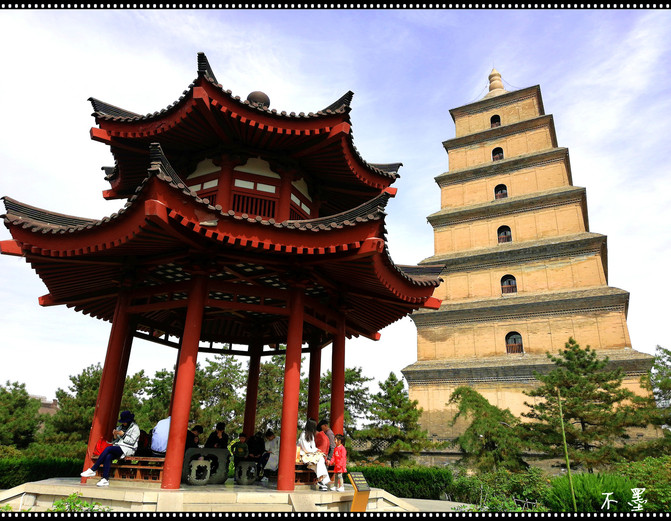
The Big Wild Goose Pagoda is located in the Dacien Temple in Xi'an City. It was built under the supervision of Xuanzang to preserve the Buddhist scroll Buddha statues brought back to Chang' an from Tianzhu via the Silk Road. It was built in the third year of Tang Yongwei (652). It initially had five floors, later increased to nine floors, and finally fixed to the seven-story tower body seen today. Contrary to the Famen Temple in Baoji, the Dayan Pagoda was built because of the pagoda.
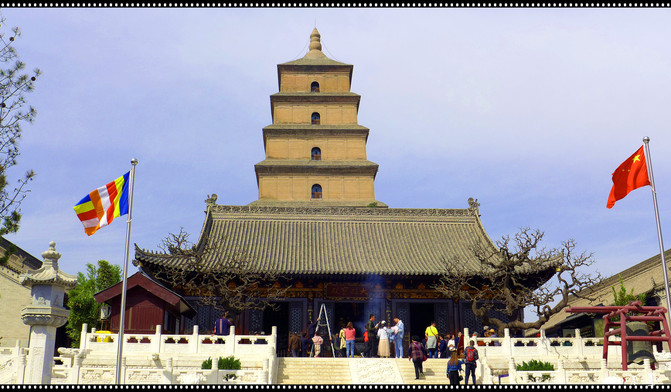
Dacien Temple was the most famous and magnificent Buddhist temple in Chang 'an City in Tang Dynasty. Xuanzang once presided over temple affairs here, led the Buddhist scriptures translation site, and founded Weishi Sect, one of the eight major sects of Han Buddhism, and became the ancestral home of Weishi Sect, so Dacien Temple has a very prominent position in the history of Chinese Buddhism.

The current Dacien Temple was built on the basis of the West Pagoda Courtyard of the Tang Dynasty in the second year of Chenghua of Xianzong of the Ming Dynasty (1466). It is only a corner of the Tang Dynasty Cien Temple and is far from the grand occasion of the Tang Dynasty.

The Big Wild Goose Pagoda brought the pagoda, an architectural form of ancient Indian Buddhism, into China with the spread of Buddhism, and became a symbol of the preservation of Chang 'an City in the Tang Dynasty. People gradually forgot the name of Dacien Temple and replaced it with the Big Wild Goose Pagoda.

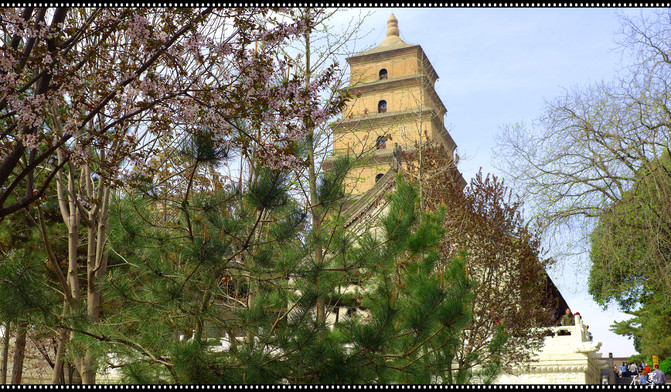
As a witness to the ancient Silk Road, the Big Wild Goose Pagoda is invaluable in cultural relics and cultural heritage.
In addition to the Buddha statues of Sakyamuni, Buddha relics, Sakyamuni footprints stele, and the lotus caisson on the top floor in the tower, the most noteworthy thing is the sutra written on Bedoro leaves in ancient India-the Bayeba Sutra. According to reports, the 657 authentic sutras retrieved by Xuanzang along the ancient Silk Road are all Bayeba Sutra. Inside the four-story tower are two pieces of Basiye Sutra about 40 centimeters long and 7 centimeters wide. They are engraved with dense Sanskrit words. It is said that there are less than 10 scholars around the world who understand this text, which is very rare.
In addition, for thousands of years, all the literati and poets who climbed the Big Wild Goose Pagoda have written poems to express their feelings, leaving behind countless excellent works, forming the "Wild Goose Pagoda Poetry Conference" and leaving a magnificent chapter in cultural history. For example, the Tang Dynasty poet Cen Shen's "Floating Picture of Climbing Cien Temple with Gao Shi and Xue Ju": The tower is like gushing out, towering tall in the sky. Climb out of the world, step on the road and pan the void... Wait, these popular poems have been passed down to the world through the ages.


The nights in Xi'an are very lively and leisurely, with both the flavor of an ancient city and the modern atmosphere. The Bell and Drum Tower is decorated with new decorations, and the old city wall is brightly lit. Although its former prosperity has ended, Chang 'an is still here in my dream.

The most lively one is Hui Street, which is a must-see place for tourists when coming to Xi'an. It is said that locals don't come to this place. They think that the food here is not authentic and the price is expensive. In fact, just like Beijingers don't go to Wangfujing and Shanghainese don't go to Nanjing Road, this place has become a landmark. Tourists no longer care what to eat or spend a few more dollars, and more importantly, shopping is an experience. If you want to taste authentic Xi'an cuisine, it is best to find a local person to take you there, often in some inconspicuous places.

There are indeed many delicious food on the street, but none of them aroused my appetite. Today I just want to eat bowl noodles.

Liuxiang noodles are in an alley. There is only one type of noodles, divided into large and small bowls. You can add meat alone or vegetables. There seem to be one or two small dishes. After ordering and paying, you can have a bowl of noodle soup first. Wait until the noodles are served, add the side dishes and add seasonings. Noodles taste very chewy, and the meat and vegetables taste very good. Although they are not very refined, they have a strong taste. There are noodles, vegetables, meat and soup. The quantity is sufficient and affordable. No wonder there are so many customers.
In the morning, we arrived at the foot of the city wall.

The Xi'an City Wall is a Ming Dynasty building and is relatively completely preserved. The city wall is tall and the towers are towering.





The outside of the city wall has been turned into a leisure park. A moat surrounds the city. Under the tall towers, green willows are only yellow, flowers are waiting to be released, and the scene of the New Year is full of people.

From time to time, sculptures and small scenes dot the area, and citizens enjoy fitness, flowers and play with pleasure.

Suzaku Gate was originally the main south gate of the Imperial City of Chang 'an in the Tang Dynasty, and the gate was Suzaku Street in the center of the city.

The city wall basically retains the pattern of the old city, and the city wall is also in its old appearance. Mottled old bricks and alkali-stained ash are like soldiers guarding the border despite the rain and wind, silently sticking to their posts.

Yongning Gate is the oldest and longest-in-use gate in Xi'an. It was built in the early Sui Dynasty (582) and is currently the most complete and beautiful restored gate among the gates of Xi'an City Wall. There is now a subway passage that allows you to enter it, or you can climb the city wall here.



The existing Xi'an City Wall should have been built during the Hongwu period of the Ming Dynasty, and it was continuously repaired before becoming what it is today. The top of the city wall is very wide, and it is more than enough for two trucks to run parallel. Strolling on the city wall is like standing on a dividing line of the times. The city walls and battlements in front of us, and the towers, arrow towers, enemy towers, and corner towers in the distance exude a simple oriental beauty. They seem to tell us about the prosperity and changes of the past, as if they came to the time of bows and armor, riding horses and archery. Outside the city wall, the numerous modern buildings, speeding cars, and modern people clearly tell us that this is a new era. Facing the new and the old, survival and abandonment, protection and development, the appearance of Xi'an City Wall gives us an answer.
Hanzhong
The Xihan Expressway from Xi'an to Hanzhong is a section of the G5. To cross the Qinling Mountains, almost all of which are tunnels and bridges. Although the scenery on both sides of the road is picturesque, we have no time to appreciate it, let alone be careless. I remember the last time I was leaving, I encountered an accident and was stuck for two hours. This time I was lucky and the journey was smooth and I arrived in Hanzhong at 4 p.m.
Hanzhong is named after the Han River. It is located at the southern foot of the Qinling Mountains, at the junction of Shaanxi, Gansu and Sichuan. Since 451 BC, the Chu State has established Hanzhong Prefecture in the middle reaches of the Han River, and the name Hanzhong is still used today.
Hanzhong has a long history, beautiful, rich and picturesque scenery. The earliest area known as the "Land of Abundance" in history refers to this. Zhuge Liang's "Longzhong Dui":"Yizhou is a dangerous fortress, with thousands of miles of fertile fields, and the land of Abundance. Gaozu took advantage of it to establish the imperial industry." Yizhou in the Han Dynasty includes today's Sichuan Basin and Hanzhong Basin. Not only that, Hanzhong is also known as the "Little Jiangnan in the Northwest" and the "Most Beautiful Sea of Rapeseed Flowers in China".

In 2007, the National Tourism Administration awarded Hanzhong the title of "China's Outstanding Tourism City". CCTV China's Best Historical, Cultural and Charming City Award Ceremony introduced Hanzhong as follows: "Hanzhong is located in the geographical center of China. It has gone through the Qin, Han, Tang and Song Dynasties, built three times and moved two times, but it has always been a crouching tiger and hidden dragon; every brick here records the vicissitudes of history, and every detail confirms the nation's success."

There is a stele inscription on the river embankment of Jiangbin Park, which is engraved with a passage from the famous scholar Mr. Yu Qiuyu,"I am Han nationality, I speak Chinese, and I write Chinese characters. This is because we once had a great dyny-the Han Dynasty." There was an important town in the Han Dynasty, Hanzhong. There were once very glorious dynasties in the world: the Roman Dynasty, the Peacock Dynasty, and our Qin and Han Dynasties. This is the pride of all mankind, and we cannot forget that great era. I came to Hanzhong to retrieve this great memory. After coming to Hanzhong, my biggest feeling is that all the mountains and rivers here have become history, and these history has become the story of our entire nation. Therefore, it would be a pity that a place like Hanzhong would not come. Therefore, I have a suggestion: let all Chinese people regard Hanzhong as their hometown and regard every time they come to Hanzhong as a return home."
According to Mr. Yu, I have gone home for the second time.
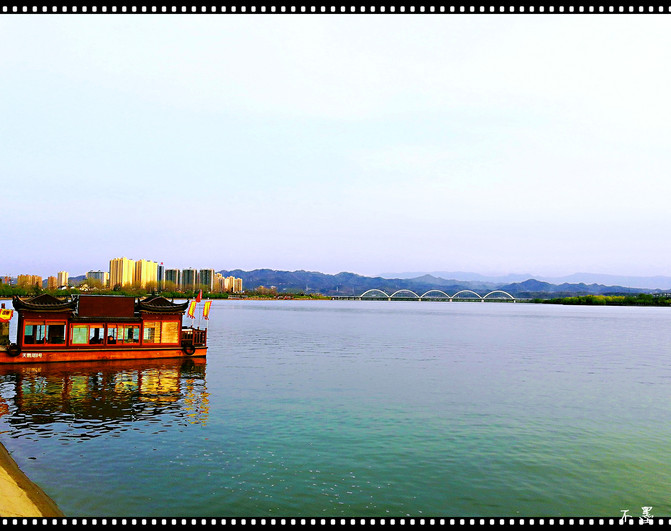

Of course, the first thing I do when I get home is to see my mother. Who is my mother? Of course it is the Han River. The Han River is the first tributary of the Yangtze River and Hanzhong's well-deserved mother river. From another perspective, the Han River is also the water source of the South-to-North Water Diversion Project. The water I drink now may flow from here. Therefore, it is more reasonable to regard the Han River as a mother, and to be grateful for her nourishment, her thoughts, and her selflessness.
The section of the Mother River flowing through the urban area of Hanzhong has a wide river surface, gentle water flow, and clear water quality. On both sides of the bank are green willows and buildings. In the distance, there are many mountains and bridges like rainbows.

As the sun sets, the tail of the sun falls into the water, drawing a colorful chain. The distant mountains are close to the water, and they are golden.



As night falls, the city shines with neon lights and the river surface shines brightly. At 8 o'clock every night, a light and music fountain show is staged on time on the river. It is very beautiful, but this time it was delayed due to dinner.
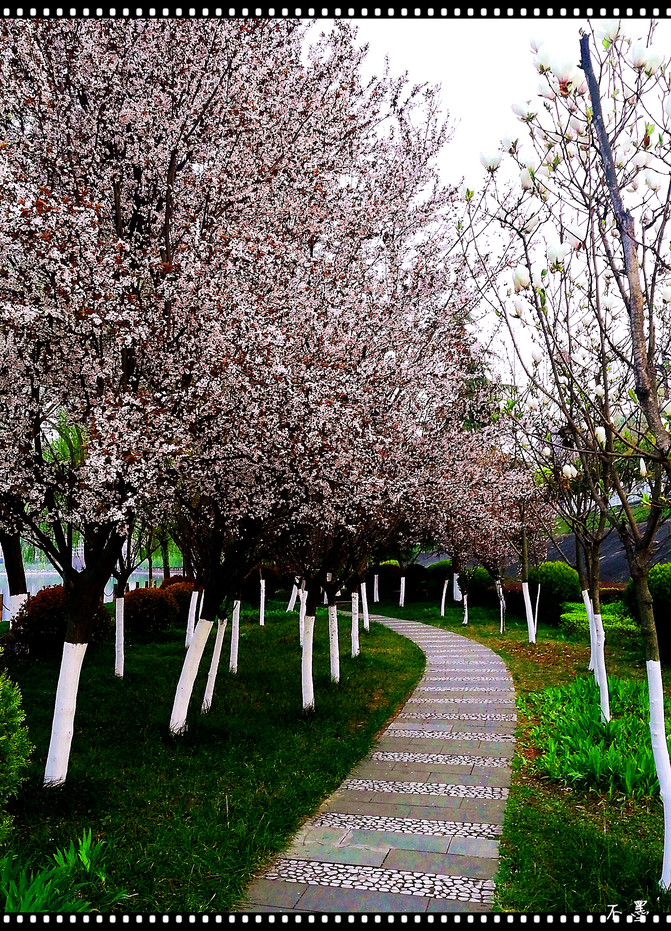
The riverside in the morning is very quiet, with few people, winding paths and flowers everywhere.

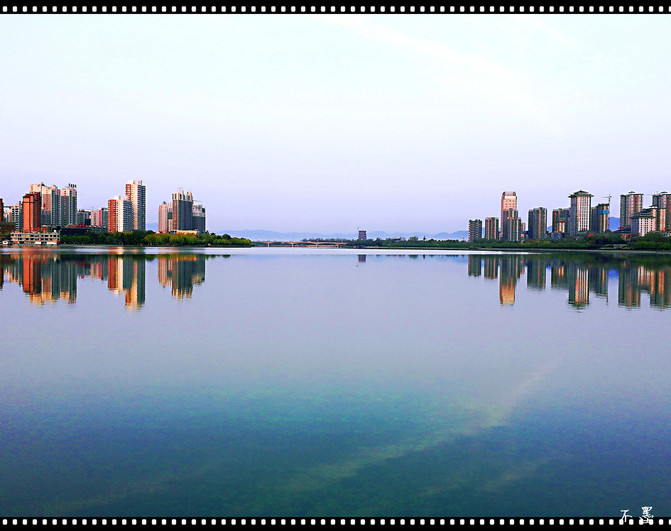

Walking along the river is a kind of enjoyment. Listening to the singing of birds, smelling the flowers of flowers, viewing the beautiful scenery on both sides of the river, and watching the floating clouds in the water. It is worthy of being a livable place. The climate, environment and landscape are really good.
Hanzhong is known as "the most beautiful sea of rapeseed flowers in China". It holds a rapeseed flower festival in March every year. This year's rapeseed flower festival begins on March 15. The rapeseed flowers in Hanzhong are not as vast and diverse as Luo Ping's mountain style. They are undulating and boundless along the mountains without gate sources. Most of them are divided into pieces and pieces by houses and villages, more like sketches, but the overall area is vast. Any roadside or village head is a place to admire flowers.
Our flower viewing route: Xiema Township-Xiemadian Village-Yuhuquan Manor-Hongfu Road-Hanshan Peak-Hanshan Square-Dashui River-Yangchun Town.
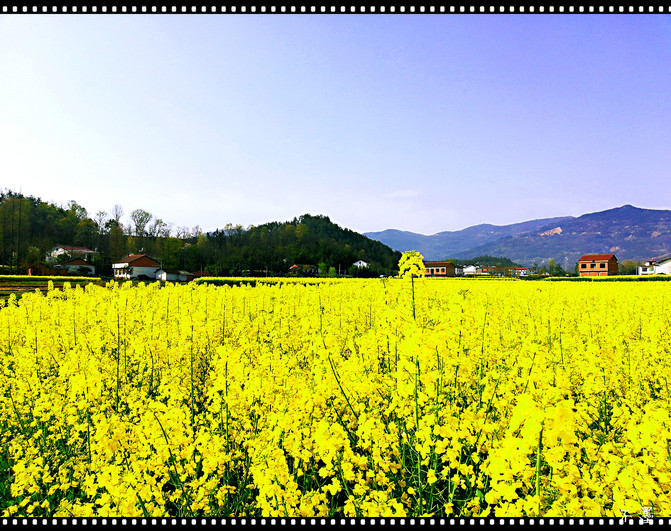


Mountain shadows, houses, flower fields, cattle grazing, everything is so simple and harmonious.

Along the mountain road, I came to a hillside and was attracted by the gorgeous flowers on the mountain. I stopped my car and climbed up the mountain. A resort courtyard was hidden among colorful flowers.


The name of the courtyard is "Yuhuquan Holiday Villa". I think it is more appropriate to call it "Huahai Courtyard". Look at the front, back, and even the roof of the courtyard are surrounded by flowers.


Living in such a small courtyard for two days is the rhythm of becoming an immortal.


Looking at the foot of the mountain here, there is a colorful beauty, like an overturned palette; it is also a three-dimensional beauty. The houses at the foot of the mountain are crisscrossed and winding, and the green trees and fields on the mountain are stacked one after another.



Halfway up the mountain, the villages and cities gradually became clearer and more beautiful. The water surface is blue and dotted with stars, and the flower fields are dotted with yellow, oranges and oranges. The roads are crisscrossed and the buildings are scattered high and low. Here is a good luck stone. I wish Hanzhong good luck and people all over the world! Good luck is given by heaven and won for yourself. Good people have good luck, but good mountains and good water are good luck.
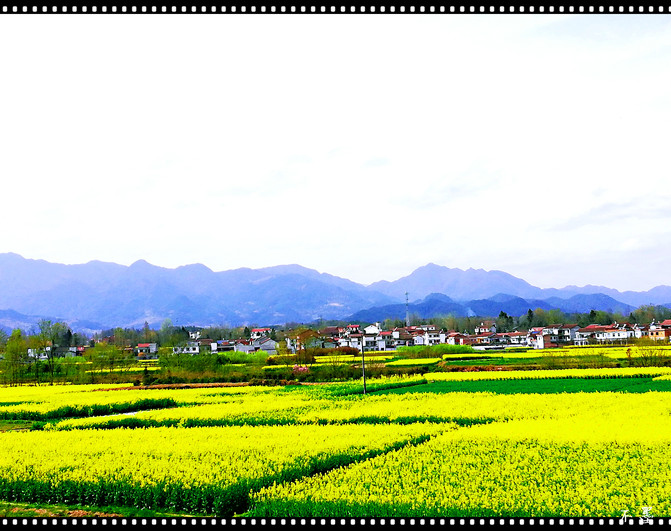

The rapeseed fields in Yangchun Town are wider and more beautiful against the backdrop of mountains and houses. In fact, rapeseed flowers are everywhere in Hanzhong. As long as you avoid people, there are beautiful scenery everywhere.
(End)
Previous Article:2021 Xi'an's latest three-day and two-night Qingming Festival and friends travel cost-effective strategies to save money
Next Article:Re-visit the Hexi Corridor in the 2019 graduation season ~ Dunhuang in my heart!
